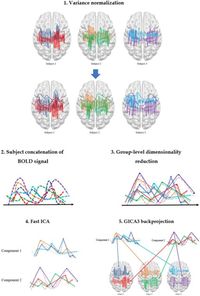A recent study highlights the neural connections between anxiety traits and brain functioning in adolescents, providing critical insight into the development of effective interventions for anxiety disorders.
As adolescents and young adults navigate developmental challenges, anxiety often becomes more pronounced. These periods are crucial as high levels of anxiety can predict future anxiety disorders. Researchers from the i-Share project investigated the potential biomarkers associated with trait anxiety in a significant cohort of 1263 young participants. Their findings, published in Scientific Reports, reveal substantial reductions in resting-state connectivity patterns linked to anxiety traits, particularly within brain networks involved in self-referential and emotional processing.
The study's sample included adolescents with a mean age of 20.55 years, with participants assessed using resting-state functional magnetic resonance imaging (rs-fMRI) and a validated anxiety trait questionnaire. In their analysis, the researchers detected significant associations between elevated anxiety scores and diminished connectivity in two independent neural networks.
"The higher the trait anxiety, the lower the connectivity within both networks, suggesting abnormal self-referential processing, awareness, and emotion regulation abilities in adolescents with high anxiety trait," wrote the authors of the article. This important finding emphasizes that the brain's communication pathways may be disrupted in those exhibiting higher anxiety traits, potentially leading to maladaptive coping behaviors.
This neuroscience research utilized advanced techniques, including group independent component analysis (ICA), to offer new insights into the workings of the adolescent brain. The investigation was grounded in data from the MRi-Share database, which houses structural and functional brain imaging data collected from a sample of young adults across France.
The implications of these findings are profound. The mapping of the default mode network (DMN) and its connectivity disturbances adds depth to the understanding of how anxiety functions in the adolescent brain. Researchers aimed to explore the relationships between anxiety traits and the resting-state functional connectivity of the DMN—regions already indicated in prior adult studies as being connected to anxiety.
The results displayed in this study illustrate that connectivity within significant brain regions, including the cingulate gyrus and the precuneus, was negatively impacted by higher anxiety levels. "Our findings underscore the importance of large-scale brain networks in understanding the neural correlates of anxiety and point toward disruptions in self-referential and sensory integration processes as key mechanisms underlying anxiety-related cognitive dysfunctions," wrote the authors of the article.
The implications for mental health treatment are notable; identifying early markers of anxiety in youth could lead to innovative approaches aimed at structuring therapeutic interventions before the onset of more serious anxiety disorders. Recognizing the neural patterns associated with anxiety may enhance predictive tools for clinicians working within adolescent mental health frameworks.
However, researchers caution the interpretation of these findings, emphasizing the necessity for further study. While connections between trait anxiety and neural networks are compelling, drawing broader conclusions about clinical anxiety disorders requires more targeted research strategies. Furthermore, teaching adolescents coping mechanisms aligned with their cognitive structures could prove beneficial, potentially diminishing future manifestations of anxiety disorders.
In conclusion, this pioneering study sheds light on the intricate relationship between anxiety traits and brain function in adolescents, pointing to the potential for new pathways in understanding and treating anxiety disorders. The use of sophisticated imaging techniques to explore extensive neural networks is paving the way for advancements in psychological care and the development of predictive models in mental health.




